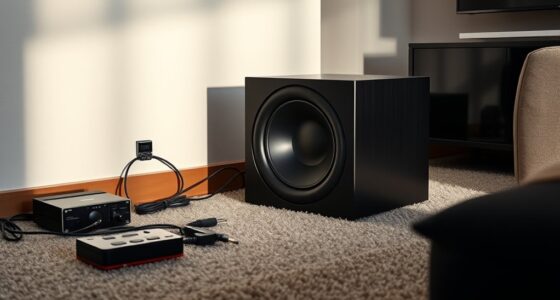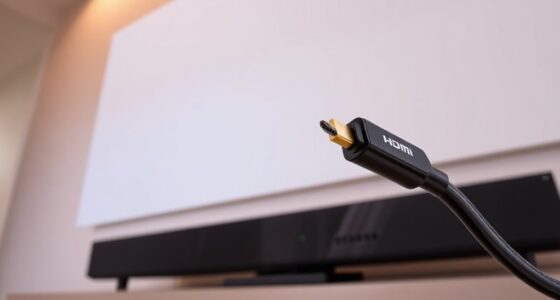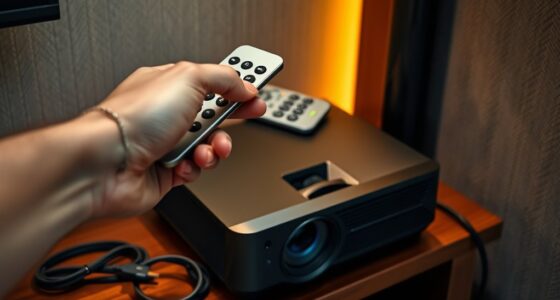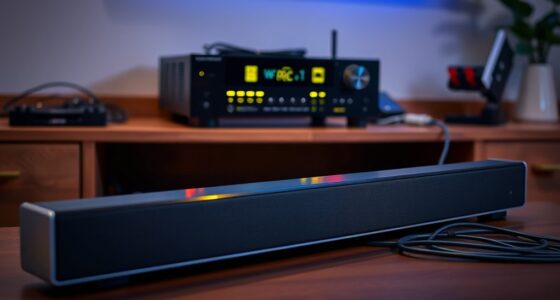To optimize your sound, start by placing your speakers at ear level and maintaining symmetry in distance and height relative to your listening spot. Use a tape measure to fine-tune placement, ensuring balanced soundwaves reach your ears evenly. Calibrate your system with test tones or built-in tools to adjust volume levels and phase. Proper placement and calibration reduce echoes and improve clarity, giving a richer experience. Keep going to discover how each step can transform your setup even further.
Key Takeaways
- Position speakers symmetrically in relation to the listening area for balanced soundstage.
- Measure and adjust distances to ensure acoustic symmetry and natural sound flow.
- Properly calibrate speakers using test tones and sound level meters for optimal audio performance.
- Avoid asymmetrical setups to prevent sound imbalance, muddiness, and echoes.
- Fine-tune placement and calibration to enhance clarity, instrument separation, and overall immersion.
Optimizing Speaker Placement and Calibration
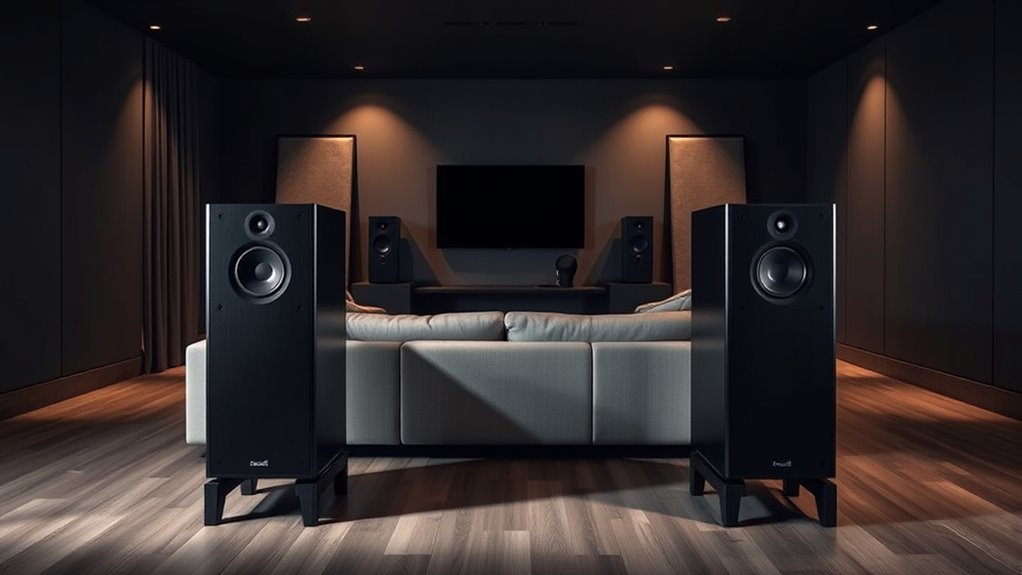
Ever wondered how to get the best sound from your speakers? It all starts with proper placement, and understanding the importance of acoustic symmetry and speaker calibration is key. When your speakers are positioned correctly, they create a balanced soundstage that immerses you in music or enhances your home theater experience. Acoustic symmetry means placing your speakers so they mirror each other in distance and height relative to your listening position. This doesn’t mean exactly equal distances in every direction, but rather ensuring the sound waves reach your ears in a way that’s balanced and natural. When speakers are asymmetrical, you might notice sound imbalance, muddiness, or echoes that detract from the clarity. Achieving acoustic symmetry involves measuring distances from each speaker to your listening spot and adjusting their placement accordingly. It’s worth investing a few minutes with a tape measure to get this right because it dramatically improves audio quality. Proper speaker placement can also help mitigate issues caused by room acoustics, which significantly influence sound clarity and richness.
Once your speakers are positioned with proper symmetry, the next step is speaker calibration. This process fine-tunes the sound output, ensuring each speaker delivers the correct level and phase for a cohesive listening experience. Many modern audio systems come with built-in calibration tools, or you can use a sound level meter and test tones. Calibration involves setting the volume levels so all speakers produce sound at the same perceived loudness, preventing one from overpowering another. It also accounts for room acoustics—furniture, walls, and even curtains influence how sound travels. Proper calibration compensates for these factors, minimizing reflections and echoes that can muddy the sound. When you calibrate your speakers correctly, you’ll notice clearer vocals, more precise instrument separation, and a more immersive experience overall.
Frequently Asked Questions
How Do I Choose the Best Speaker Types for My Room?
To choose the best speaker types for your room, consider your room acoustics and speaker compatibility. If your space has lots of reflections, opt for speakers with built-in acoustic treatments or use placement techniques to reduce echo. For compatibility, match speaker size and power handling with your amplifier and room size. Test different options, listen critically, and adjust placement to optimize sound quality, ensuring your setup suits your room’s unique acoustics.
What Tools Are Essential for Precise Speaker Calibration?
Think of precise speaker calibration as blending art with science. You’ll need acoustic measurement tools like a calibrated microphone and sound level meter to gather accurate data. Calibration software then processes this data, helping you fine-tune your system for perfect sound. These tools work together, ensuring your speakers deliver balanced, immersive audio. Without them, you’re guessing; with them, you’re achieving professional-level sound quality effortlessly.
Can Speaker Placement Affect Wi-Fi Signal Strength?
Speaker placement can indeed affect Wi-Fi signal strength, especially if you’re in a space with wireless interference. Positioning speakers too close to Wi-Fi routers or other electronic devices can disrupt the signal. Additionally, proper acoustic balancing ensures your speakers are placed most effectively, reducing the need to move equipment around and minimizing interference. To maintain strong Wi-Fi, keep speakers and routers apart, and consider how placement impacts both sound quality and wireless performance.
How Often Should I Recalibrate My Speaker System?
You should recalibrate your speaker system every 6 to 12 months to maintain ideal sound quality. Regular calibration helps extend your speaker lifespan by preventing performance issues caused by shifting settings or environmental changes. If you notice a decline in sound clarity or volume, it’s a good idea to recalibrate sooner. Consistent calibration frequency ensures your speakers deliver the best audio experience and stay in top condition over time.
Are There Specific Guidelines for Multi-Room Speaker Setups?
Think of your multi-room setup as a well-orchestrated symphony. To achieve perfect harmony, follow zoning strategies that keep sound balanced across rooms. Guarantee multi-room synchronization by placing speakers thoughtfully, considering acoustics, and using a central controller. Keep the volume levels consistent and avoid overlapping frequencies. Regularly check and calibrate to maintain clarity, so your home’s audio experience stays seamless, like a conductor guiding every instrument in tune.
Conclusion
Now that you’ve mastered speaker placement and calibration, your sound system will feel as legendary as a Voyager’s voyage. Remember, fine-tuning takes patience—think of it like tuning a vintage radio. Don’t be afraid to experiment and trust your ears. With these tips, your space will be filled with crystal-clear audio, making every listening session epic. So go ahead, channel your inner audio wizard and create a soundscape that’s truly out of this world!


